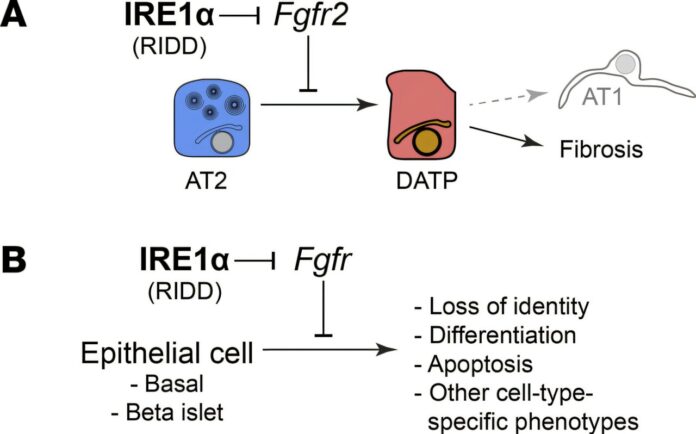Tiny fat bubbles carrying gene therapy have successfully repaired DNA in the lungs and liver of animals with alpha-1 antitrypsin deficiency—a promising leap toward treating humans with this rare inherited disease.
In a paper published in the journal Nature Biotechnology, researchers at UT Southwestern Medical Center introduced lipid nanoparticles—hollow, fatty spheres often 100,000 times smaller than the thickness of a piece of paper—that seek out and enter both lung and liver cells. This is significant because lipid nanoparticles tend to gather naturally in the liver versus other organs and tissues.
In mice genetically engineered with a mutation causing alpha-1 antitrypsin deficiency, these selective organ-targeting lipid nanoparticles delivered a payload of curative gene therapy, correcting about 40% of liver cells and 10% of lung cells affected by the disease. This also reduced levels of an abnormal protein associated with the genetic condition by over 80%.
“[The researchers] are getting results that haven’t been gotten before,” said Dr. Terence Flotte, a pediatric pulmonologist and dean of the University of Massachusetts T.H. Chan Medical School, who was not involved in the study. “It looks pretty darn convincing to me.”
A new approach
Alpha-1 antitrypsin deficiency is a genetic disorder that harms the lungs, the liver or sometimes both. About 80,000 to 100,000 people in the U.S. have it, all because of mutations in the SERPINA1 gene.
This gene normally makes alpha-1 antitrypsin, a protein produced in the liver that travels through the blood to the lungs to protect them from neutrophil elastase, an enzyme released during inflammation and infection. But when the protein is missing or misshapen by a SERPINA1 mutation, which causes it to clump up in the liver instead of reaching the lungs, neutrophil elastase runs wild and starts eating away at healthy lung tissue.
Treatments such as augmentation therapy, which raises protein levels with plasma from healthy donors, can ease symptoms, but there’s no cure for alpha-1 antitrypsin deficiency. Today, scientists are looking to gene therapy as a promising new approach.
This is where lipid nanoparticles come in. These modern successors to the liposomes discovered in the 1960s can be loaded with almost any kind of cargo, from vaccines (like COVID-19 shots) to chemotherapy drugs and antibiotics. But when it comes to gene therapies, one of the biggest challenges is steering lipid nanoparticles to the right cells in need of repair.
The liver—which handles making, breaking down and storing fat—often intercepts these fatty particles, which naturally gravitate to the spongy, reddish-brown organ and are absorbed by its cells, known as hepatocytes.
Figuring out how to create a lipid nanoparticle that can home in on other organs and tissues is a puzzle Daniel Siegwart, a professor of biomedical engineering at UTSW, has been trying to solve since he arrived in Dallas over a decade ago from the Massachusetts Institute of Technology.
“When I joined [UTSW] in 2012, I wrote the top five challenges in my field on a whiteboard,” said Siegwart, who led the study. “One of those problems was that all nanoparticles accumulate in the liver. It’s great for liver disease, but it’s going to hinder therapies for everything else.”
Lock and key
Lipid nanoparticles have special molecular parts on their surfaces that latch onto matching structures on a cell, like a key turning in a lock. Once they connect, the cell pulls the nanoparticle inside.
Siegwart and his colleagues thought changing the molecular parts to fit a specific organ or cell would be the solution to the nanoparticles huddling in the liver. Through several years of experimentation, they arrived at a recipe for lipid nanoparticles that could target selective organs.
Lipid nanoparticles, Siegwart said, are typically made of four lipids. One is an ionizable aminolipid that grabs onto the genetic cargo and releases it inside cells. Another is cholesterol. A third is a phospholipid, borrowed from the early days of liposomes. And the fourth is a polyethylene glycol-lipid, which helps keep the particles stable and improves how they travel through the body. The ratio of these components affects the size, shape, charge and stability of the particle.
Together, nanoparticles made from these four lipids still went to the liver. But the researchers found if they added a fifth lipid—Siegwart calls it DORI (its actual chemical name is a 74-character mouthful)—it would make a beeline to the lungs, entirely bypassing the liver, he said.
To test how well these selective organ-targeting lipid nanoparticles worked in the case of alpha-1 antitrypsin deficiency, Siegwart and his colleagues loaded the tiny fatty couriers with a base editor that corrects a variant of the mutated SERPINA1 gene called Z. Base editors are akin to chemical word processors, fixing single typos in the genetic code.
Young mice genetically engineered to have alpha-1 antitrypsin deficiency were injected with the liver- and lung-targeting lipid nanoparticles. After some weeks, Siegwart and his colleagues examined the livers and lungs of the mice and found that, remarkably, about 40% of their liver cells were corrected, as well as 10% of their lung cells, particularly those that repair the lungs and produce a lubricant called surfactant.
“We found that level of correction led to 80% restoration of the normal liver and about 90% restoration of the lungs,” Siegwart said.
Paving future plans
The study comes as Boston-based biotech Beam Therapeutics announced initial data in March of an early-stage clinical trial for its alpha-1 antitrypsin deficiency gene therapy.
Called BEAM-302, this gene therapy targets the SERPINA1 gene mutation in the liver, correcting it so the organ can produce properly folded, rather than misshapen, alpha-1 antitrypsin.
“Their theory is that’s all you need to treat both liver and lung [in alpha-1 antitrypsin deficiency],” said Flotte of the UMass Chan Medical School. “There is also an accumulating body of evidence … that some element of the lung disease occurs because the mutant alpha-1 antitrypsin made right there in the lungs is harmful.”
Selective organ targeting lipid nanoparticles could offer a way to treat the genetic condition in the lungs and liver, Flotte said. But more research is needed to understand how long these corrections will last—in Siegwart’s mice, the gene-editing effects persisted for 32 weeks—and how effective this approach might be in other animals. For example, in ferrets with alpha-1 antitrypsin deficiency, scientists can run some of the same tests as are done in humans.
Siegwart said he and his colleagues hope to explore other animal models in the future. In the meantime, he’s excited about the potential of using selective organ targeting lipid nanoparticles to tackle other genetic diseases, including cystic fibrosis and primary ciliary dyskinesia, a rare disorder that affects the tiny, hair-like structures lining the airways.
People born with primary ciliary dyskinesia are prone to chronic respiratory infections and may have organs in unusual positions within the chest and abdomen.
California-based ReCode Therapeutics, which Siegwart co-founded, is already studying these lipid nanoparticles as delivery vehicles for gene therapies targeting both conditions. In March, the company received Orphan Drug Designation from the U.S. Food and Drug Administration for an investigational cystic fibrosis gene therapy, a status reserved for promising treatments aimed at rare diseases.
More information:
Delivering base editors to the liver and lungs in alpha-1 antitrypsin deficiency, Nature Biotechnology (2025). DOI: 10.1038/s41587-025-02705-w
Minjeong Kim et al, Dual SORT LNPs for multi-organ base editing, Nature Biotechnology (2025). DOI: 10.1038/s41587-025-02675-z
2025 The Dallas Morning News. Distributed by Tribune Content Agency, LLC.
Citation:
Rescued by fat bubbles: Scientists treat rare genetic disease with designer molecule (2025, July 20)
retrieved 21 July 2025
from https://medicalxpress.com/news/2025-07-fat-scientists-rare-genetic-disease.html
This document is subject to copyright. Apart from any fair dealing for the purpose of private study or research, no
part may be reproduced without the written permission. The content is provided for information purposes only.


